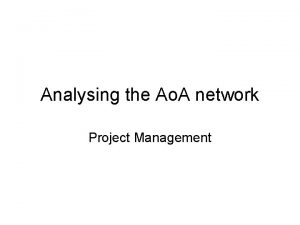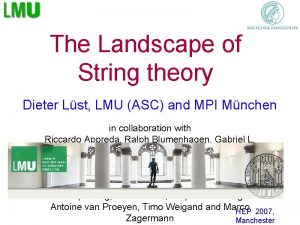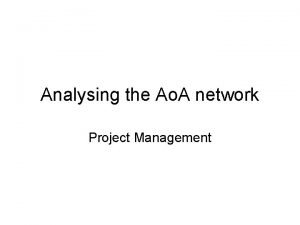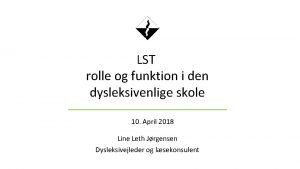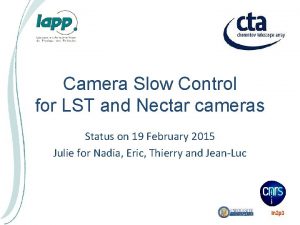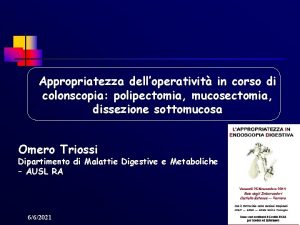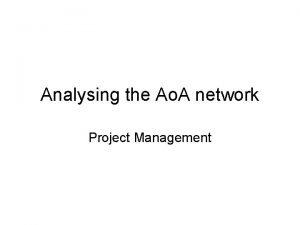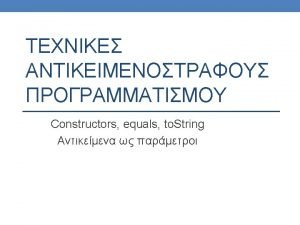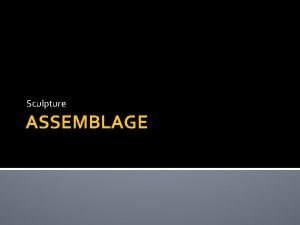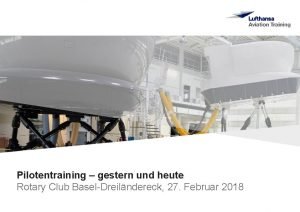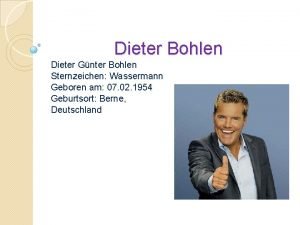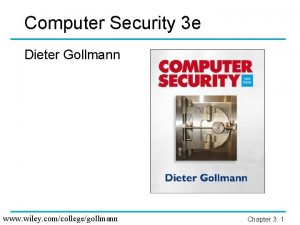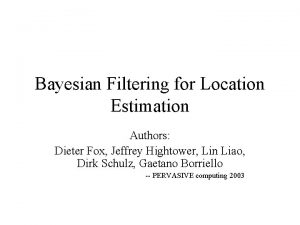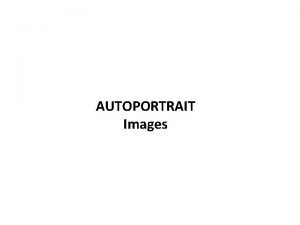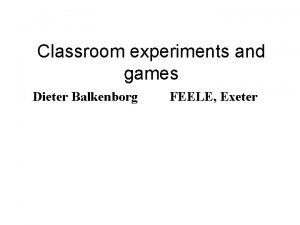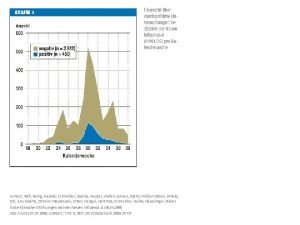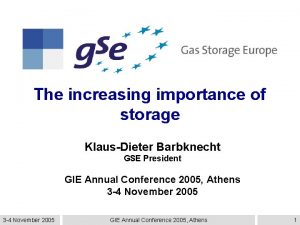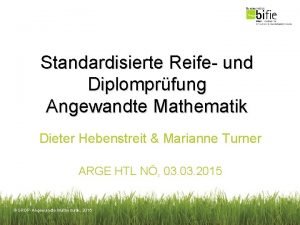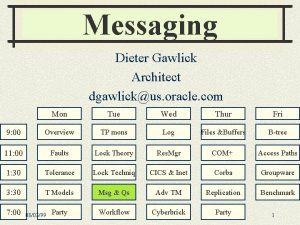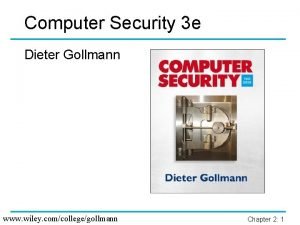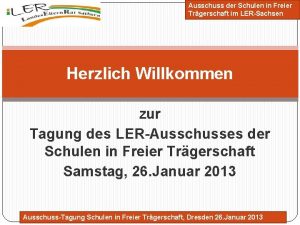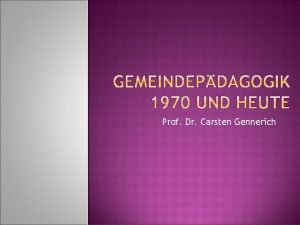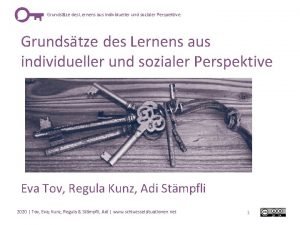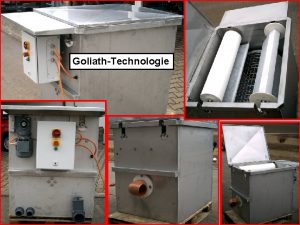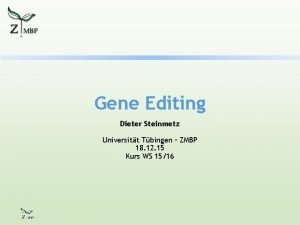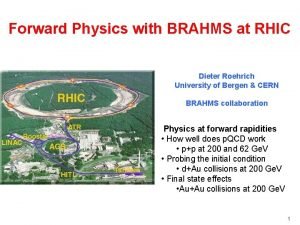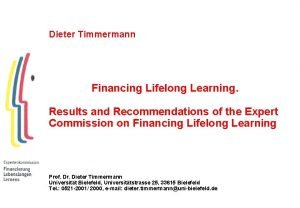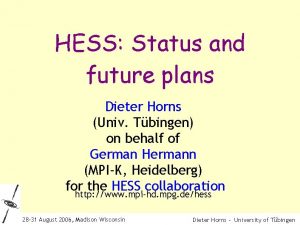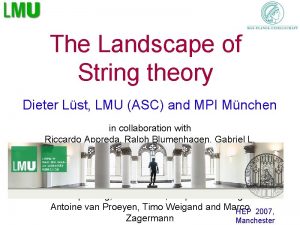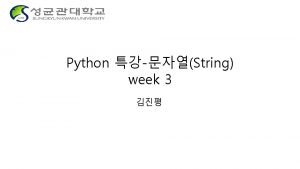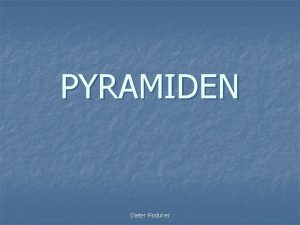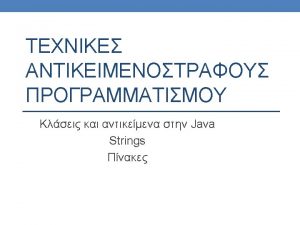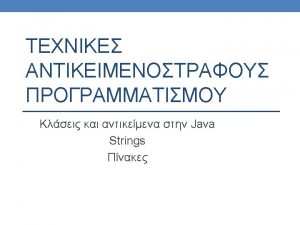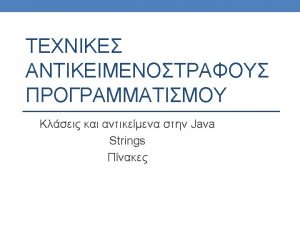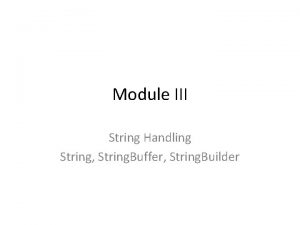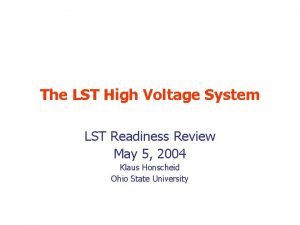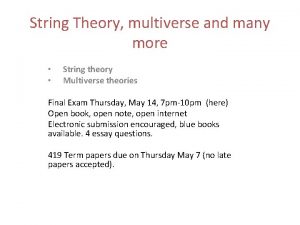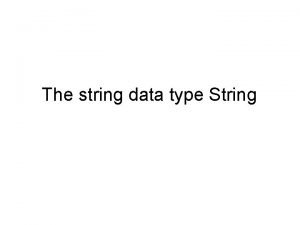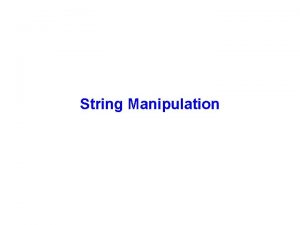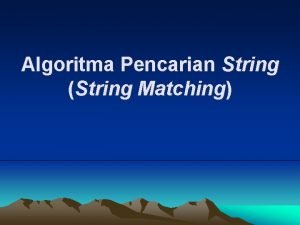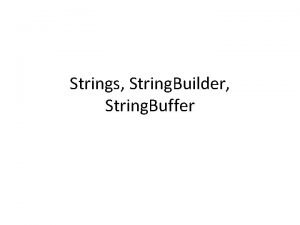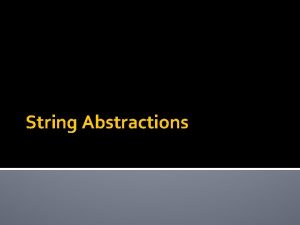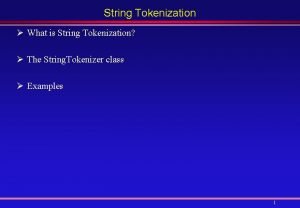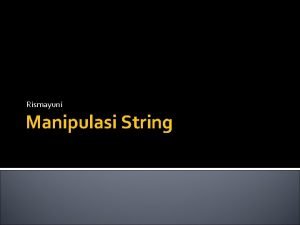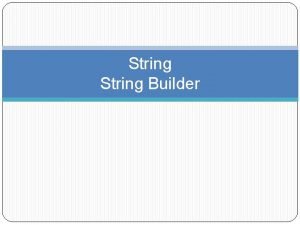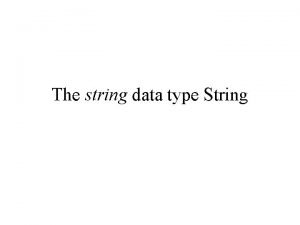The Landscape of String theory Dieter Lst LMU


































- Slides: 34

The Landscape of String theory Dieter Lüst, LMU (ASC) and MPI München in collaboration with Riccardo Appreda, Ralph Blumenhagen, Gabriel L. Cardoso, Mirjam Cvetic, Johanna Erdmenger, Florian Gmeiner, Viviane Grass, Michael Haack, Daniel Krefl, Gabriele Honecker, Jan Perz, Susanne Reffert, Robert Richter, Christoph Sieg, Maren Stein, Stephan Stieberger Antoine van Proeyen, Timo Weigand Marco HEP 2007, Zagermann Manchester

I) Introduction Geometry: Calabi-Yau spaces, mirror symmetry, generalized spaces, D-branes (submanifolds), K-theory, Gromov/Witten invariants, . . . Black Hole Entropies String Theory ? ? ? (Topological) supersymmet ric field theories Physics HEP 2007, Manchester

I) Introduction ☺ Quantum Gravity Gauge (4 D) - Gravity (5 D) Correspondence ☺ Gauge Interactions ● Standard Model of Particle Physics and its high energy completion (MSSM, GUT, . . . ) ☛ with 3 generations of quarks and leptons ☛ Calculable couplings -- unification! ☛ Low energy supersymmetry ➢ LHC (2008)? ☛ Gauge theory dynamics ☛ New testable experimental signatures HEP (extra 2007, dimensions, black holes)? ? Manchester

Count the number of consistent string solutions ➤ Vast landscape with vacua! discrete (Lerche, Lüst, Schellekens (1986), Douglas (2003)) Two strategies to find something interesting: ● Explore all mathematically consistent possibilities: top down approach (quite hard), string statistics ●(perhaps Do not look randomly - look some anthropic pointfor ofgreen view is(promising) necessary? ) spots in the landscape ➠ model building, bottom up HEP 2007, Manchester

Outline ● Some new results on the Ad. S/CFT correspondence ☞ Tests ☞ Some steps towards QCD ● Heterotic string compactifications ● Type II orientifolds models Intersecting brane models and their statistics D-instantons: non-perturbative couplings ● Outlook: Prospects for the next years (Review: D. Lüst, ar. Xiv: 0707: 2305) HEP 2007, Manchester

II) Some new results on the Ad. S/CFT correspondence (Maldacena (1997)) closed strings open strings ↓ low energy limit N=4 supersym. SU(N) ↔ gauge theory Superstring (supergravity) on The correspondence is so far tested for: HEP 2007, Manchester

Key issues: ● How to test the duality at weak gauge (`t Hooft) coupling? ☛ Integrability of N=4 SYM! ● Steps towards realistic QCD? ☛ Adding flavor to Ad. S/CFT. (Break N=4 SUSY & conformal symmetry and introduce quarks) ☛ Explore universal features! (High temperature QCD) HEP 2007, Manchester

Outline ● Some new results on the Ad. S/CFT correspondence ☞ Tests ☞ Some steps towards QCD ● Heterotic string compactifications ● Type II orientifolds models Intersecting brane models and their statistics D-instantons: non-perturbative couplings ● Outlook: Prospects for the next years HEP 2007, Manchester

Tests of the Ad. S/CFT correspondence: Consider the anomalous dimension of twist-2 operators: (spin chain!) 2 perturbative regimes for the universal scaling function: Perturbative gauge theory: Perturbative string theory: Can one match these two PERFECT MATCH! Betheexpansions? ansatz, integrability ➠ analytic (Minahan, Zarembo (2004); Beisert, Eden, Staudacher (2006); Alday, Maldacena, expression for Swanson (2007). . ) (Bern, Czakon, Dixon, Kosower, Smirnov (2006); Cachazo, Spradlin, Volovich (2007), 4 -loop N=4 YM-scattering ampl: HEP 2007, Manchester

Outline ● Some new results on the Ad. S/CFT correspondence ☞ Tests ☞ Some steps towards QCD ● Heterotic string compactifications ● Type II orientifolds models Intersecting brane models and their statistics D-instantons: non-perturbative couplings ● Outlook: Prospects for the next years HEP 2007, Manchester

Adding flavor to Ad. S/CFT: ch, Katz (2003); Apreda, Babington, Erdmenger, Evans, Guralnik, Kirsch (2003/04)). . . We want to come closer to real QCD: ➢ Break supersymmetry and conformal symmetry: Deformation of Ad. S-space: ➢ Add quark flavor fields in fundamental repr. of SU(N): Include D 7 -branes: Quarks are open strings, stretched between D 3 - and D 7 -branes. HEP 2007, Manchester

Some results: ☻ Chiral symmetry breaking: ☻ Compute meson masses: Light Goldstone boson Heavy (axial) vector bosons: ☻ D 7 -branes in Polchinski/Strassler background with fluxes. (Apreda, Erdmenger, Sieg, Lüst (2006)) ☻ Alternative models: D 4/D 8 -branes (Sakai, Sugimoto (2004/05); Antonyan, Harvey, Kutasov (2006)) HEP 2007, Manchester

Ad. S/CFT and the quark gluon plasma: Study QCD in the deconfined quark-gluon plasma phase (high temperature QCD): Behaves like liquid with viscosity : RHIC experiment (T=250 Me. V, Its gravity dual contains a Ad. S 5 black hole of (Witten (1998)) Hawking temperature. N=4 SUSY D 3 -brane (Policastro, Son, Starinets background: (2001)) UNIVERSAL BEHAVIOR? More realistic models: Inclusion of quarks via D 7(Mateos, branes. Myers, Thomson (2006)) HEP 2007, Manchester

Some more remarks: ● New techniques for computing QCD on-shell amplitudes. (Bern, Dixon, Kosower; Schwinn, Weinzierl; . . ) ➣ Important for QCD background at LHC! ● Twistor approach (pure spinors): (Witten; Berkovits; . . . ) ➣ Computation of MHV amplitudes. Higher order corrections: (Stieberger, Taylor) Relevant if low string scale at LHC! ● 3 -loop Finiteness of N=8 supergravity! (Bern, Dixon, Roiban (2006)) HEP 2007, Manchester

Outline ● Some new results on the Ad. S/CFT correspondence ☞ Tests ☞ Some steps towards QCD ● Heterotic string compactifications ● Type II orientifolds models Intersecting brane models and their statistics D-instantons: non-perturbative couplings ● Outlook: Prospects for the next years HEP 2007, Manchester

III) Heterotic String Compactifications: 10 dimensions: gauge group supersymmetric compactification to 4 dimensions (i) Choice of internal 6 -dimensial manifold : Calabi-Yau space, orbifold (ii) Choice of stable vector bundle V = H : over SUSY: 4 D gauge group ; tadpoles: : 4 D chiral matter fields: HEP 2007, Manchester

Heterotic CY Compactifications (i) (elliptically fibred) CY with H being a simple (Friedman, Morgan, Witten (1997); Andreas, Curio, group: Klemm (1999); Donagi, Ovrut, Pantev, Waldram (2000); . . . ) GUT Models: No adjoint Higgs: need discrete Wilson line to break to (ii) (elliptically fibred) CY with H being a non-simple group: (Blumenhagen, Honecker, Weigand (2005); . . . ) Flipped SU(5): SM: HEP 2007, Manchester

Resume: heterotic strings: ● Heterotic CY compactifications are mathematically interesting, but also complicated. ☺ 3 generation CY models without exotic partices He, Ovrut, Pantev (2005); can be constructed. (Braun, Bouchard, Donagi (2005)) ☺ Nice SO(10) GUT models from orbifolds. (Kobayashi, Raby, Zhang (2004); , . . . Buchmüller, Hamaguchi, Lebedev, Ratz (2005); Lebedev, Nilles, Raby, Ramos-Sanchez, Ratz, Vaudrevange (2006); . . . ) ☹ Moduli stabilization (bundle moduli!) with Hflux is difficult. (Strominger (1985), Becker, Dasguta, Green (2003); Curio, Cardoso, Dall‘Agata, Lüst, Krause (2003/04/05); Braun, He, Ovrut (2006)) HEP 2007, Manchester

Outline ● Some new results on the Ad. S/CFT correspondence ☞ Tests ☞ Some steps towards QCD ● Heterotic string compactifications ● Type II orientifolds models Intersecting brane models and their statistics D-instantons: non-perturbative couplings ● Outlook: Prospects for the next years HEP 2007, Manchester

IV) (Intersecting) D-brane models: (Bachas (1995); Blumenhagen, Görlich, Körs, Lüst (2000); Angelantonj, Antoniadis, Dudas Sagnotti (2000); Ibanez, Marchesano, Rabadan (2001); Cvetic, Shiu, Uranga (2001); . . . ) Now consider open string compactifications with intersecting D-branes ➠ Type IIA/B orientifolds: They exhibit several new features: ● Non-Abelian gauge bosons live as open strings on lower dimensional world volumes of D-branes. ● Chiral fermions are open strings on the intersection locus of two D-branes: ● Can be combined with background fluxes ➠ moduli stabilization (GKP) and d. S-vacua (KKLT) HEP 2007, Manchester

Perturbative type II orientifolds contain: (Review: Blumenhagen, Körs, Lüst, Stieberger, hepth/0610327) ● Closed string 6 -dimensional background geometry: -Torus, orbifold, Calabi-Yau space, generalized spaces with torsion, . . . - Background fluxes: ● Space-time filling D(4+p)-branes wrapped around internal p-cycles: - Open string matter fields. (diophantic ● Strong consistency conditions: equations with - tadpole cancellation with orientifold planes. finite no. of solutions!) - space-time supersymmetry (brane stability) HEP 2007, Manchester

Space-time filling D-branes: Geometrical, large radius regime: special lagrangian submanifolds: D 6 on 3 -cycles at angle Mirror symmetry (SYZ) IIB: points, (complex lines), divisors, (CY) with gauge bundles: D 3 (D 5) D 7 (D 9) Soft SUSY breaking HEP 2007, Manchester

(Intersecting) D-brane statistics How many orientifold models exist which come close to the (spectrum of the) (Blumenhagen, Gmeiner, Honecker, Lüst, Stein, Weigand, hep-th/0411173, hep-th/0510170, hep. MSSM? th/0703011; related work: Dijkstra, Huiszoon, Schellekens, hep-th/0411129; Anastasopoulos, Dijkstra, Kiritsis, Schellekens, hep-th/0605226; Douglas, Taylor, hep-th/0606109; Dienes, Lennek, hep-th/0610319) Example: IIA orientifold: Systematic computer search (NP complete problem): Look for solutions of a set of diophantic equations: There exist about susy D-brane models on this orbifold (with restricted complex structure)! (Finiteness of models was recently proven by HEP 2007, D. T. ) Manchester

(Intersecting) D-brane model building Require additional further phenomenological restrictions: Only one in a billion models gives rise to a MSSM like HEP 2007, vacuum! Manchester

More results: (Gmeiner, Stein, hep-th/0603019; Gmeiner, Lüst, Stein, 0703011) ● D-brane statistics: (i) Z 6 -orientifold: (exceptional, blowing-up 3 -cycles!) In total susy D-brane models. of them possess MSSM like spectra! (ii) Similar results are obtained for SU(5) GUT models. ● Explicit D-brane constructions: there exist many models that come close to the MSS Problem of exotic particles! (Chen, Li, Mayes, Nanopoulos, hep-th/0703280; Chen, Li, Nanopoulos, hep-th/0604107; Blumenhagen, Plauschinn, hep-th/0604033; Bailin, Love, hep-th/0603172; Blumenhagen, Cvetic, Marchesano, Shiu, hep-th/0502095; Marchesano, Shiu, hep-th/0409132; Honecker, Ott, hep-th/0407181; . . . ) HEP 2007, Manchester

Outline ● Some new results on the Ad. S/CFT correspondence ☞ Tests ☞ Some steps towards QCD ● Heterotic string compactifications ● Type II orientifolds models Intersecting brane models and their statistics D-instantons: non-perturbative couplings ● Outlook: Prospects for the next years HEP 2007, Manchester

Non-perturbative D-instantons: (M. Dine, N. Seiberg, X. Wen, E. Witten; K. Becker, M. Becker, A. Strominger; M. Green, M. Gutperle; J. Harvey, G. Moore; M. Billo, M. Frau, F. Fucito, A. Lerda, I. Pesandro; N. Dorey, T. Hollowwod, V. Khoze; . . Recent review: M. Bianchi, S. Kovacs, G. Rossi) Perturbative effective action: ● SM-sector: Contains global U(1) symmetries that forbid certain couplings (neutrino masses, Yukawa ●couplings) Hidden sector: Not all moduli are stabilized (by fluxes). ● Unbroken space-time supersymmetry. Take into account non-perturbative instanton corrections to the effective action! HEP 2007, Manchester

String instanton corrections: ● String instantons arise in a geometric way from wrapped around internal cycles. ● branes It is possible to compute string instanton corrections from open string CFT (not only guess (R. Blumenhagen, M. Cvetic, T. Weigand, hep-th/0609191) them from field theory). ● String instantons can break axionic shift symmetries and hence global U(1) symmetries. ● Can generate new moduli dependent terms in the superpotential and hence are important for the (S. Kachru, R. Kallosh, A. Linde, S. Trivedi (2003); F. moduli stabilization. Denef, M. Douglas, B. Florea, A. Grassi, S. Kachru (2005); D. L. , S. Reffert, E. Scheidegger, W. Schulgin, S. Stieberger(2006)) ● Can generate new matter couplings (Majorana masses, HEP 2007, Yukawa couplings) → see in a moment. Manchester

Two kinds of string instantons: . Tree-level in ● World-sheet instantons: CFT! ●Space-time instantons: These are non-space time filling D(p)=E(p) branes wrapped around internal (p+1)-cycles: IIA: special lagrangian submanifolds: E 2 on 3 -cycles 2 possible cases: ● E 2 is wrapping the same 3 -cycle as the gauge group: E 2 -brane corresponds to a gauge instanton ⇒ ADS supe (N. Akerblom, R. Blumenhagen, D. Lüst, E. Plauschinn, M. Schmidt-Sommerfeld, hepth/0612032; Argurio, Bertolini, Ferretti, Lerda, Petersson, ar. Xiv: 0704. 0262) ● E 2 is wrapping a 3 -cycle different from the gauge group: E 2 -brane describes a genuine string instanton. HEP 2007, Manchester

Non-perturbative Yukawa couplings: (R. Blumenhagen, M. Cvetic, D. Lüst, R. Richter, T. Weigand, ar. Xiv: 0707. 1871) SU(5) GUT intersecting brane models: erturb. allowed couplings(e. g. u, c, t-quarks): erturb. forbidden couplings (e. g. d, s, b-quarks): These can be generated by E 2 instantons: E 2 -instantons also relevant for doublet-triplet splitting, Majorana masses, masses for exotic states, . . . (Ibanez, Uranga, hep-th/0609213; Cvetic, Richer, Weigand, hepth/0703028; Ibanez, Schellekens, Uranga, ar. Xiv: 0704. 1079; Antusch, Ibanez, Macri, ar. Xiv: 07062132; Bianchi, Kiritsis, ar. Xiv: 0702015; Bianchi, HEP 2007, Manchester

Prospects for the next years: Strings make very dramatic qualitative predictions! ➠ Supersymmetry ➠ Extra dimensions These are captured well by the LHC! Work out possible connections and details between supergravity & string theory with LHC and astroparticle physics. (How good is the chain between fundamental theory and the data? ) HEP 2007, Manchester

What do we like to learn: ● Where is the fundamental string scale? ● Where is the scale of supersymmetry breaking? ● Where is the scale of the extra dimensions? ● Where are we in the landscape? Plan for the next years: Bottom-up approach: Work upstairs from experimatal data. Success? ↕ Top-down approach: Develop high scale theory from mathematical consistency (How good is the chain between fundamental HEP 2007, theory and the data? ) Manchester

What about the string landscape? Is there a vacuum selection mechanism? ● (Unknown) dynamics ➠ Unique vacuum? ● String statistics (Anthropic answer): determine the fraction of vacua with good phenomenological properties: ●Entropy of string vacua (Entropic answer): determine a probability function in moduli space, and see if good is peaked, i. e. has maxima with HEP 2007, Manchester

Conclusions We know several (perturbative) vacua of string theory. How does string theory really look like? Thank you!
 Est eft lst lft
Est eft lst lft Lmu lst
Lmu lst Licenseid=string&content=string&/paramsxml=string
Licenseid=string&content=string&/paramsxml=string What is free float and total float
What is free float and total float Dysleksivenlig skole
Dysleksivenlig skole Nectar camera
Nectar camera Classificazione di parigi polipi
Classificazione di parigi polipi Float activity
Float activity Ar-lst
Ar-lst Const char *s =
Const char *s = Class person string name
Class person string name Java new string
Java new string Additive process in art
Additive process in art Dieter eppler pilot
Dieter eppler pilot Sternzeichen dieter bohlen
Sternzeichen dieter bohlen Computer security dieter gollmann
Computer security dieter gollmann Dieter fox
Dieter fox Klaus dieter frey
Klaus dieter frey Tony cragg autoportrait 1981
Tony cragg autoportrait 1981 Feele exeter
Feele exeter Sophie schneitler
Sophie schneitler Klaus-dieter barbknecht
Klaus-dieter barbknecht Sdrp mathe
Sdrp mathe Dieter gawlick
Dieter gawlick Computer security dieter gollmann
Computer security dieter gollmann Dieter dresch
Dieter dresch Dieter aschenbrenner
Dieter aschenbrenner Hans dieter frey
Hans dieter frey Dieter timmermann
Dieter timmermann Dieter binder zaisersweiher
Dieter binder zaisersweiher Steinmetz kurs
Steinmetz kurs Dieter steinmetz
Dieter steinmetz Dieter röhrich
Dieter röhrich Dieter timmermann
Dieter timmermann Dieter horns
Dieter horns
